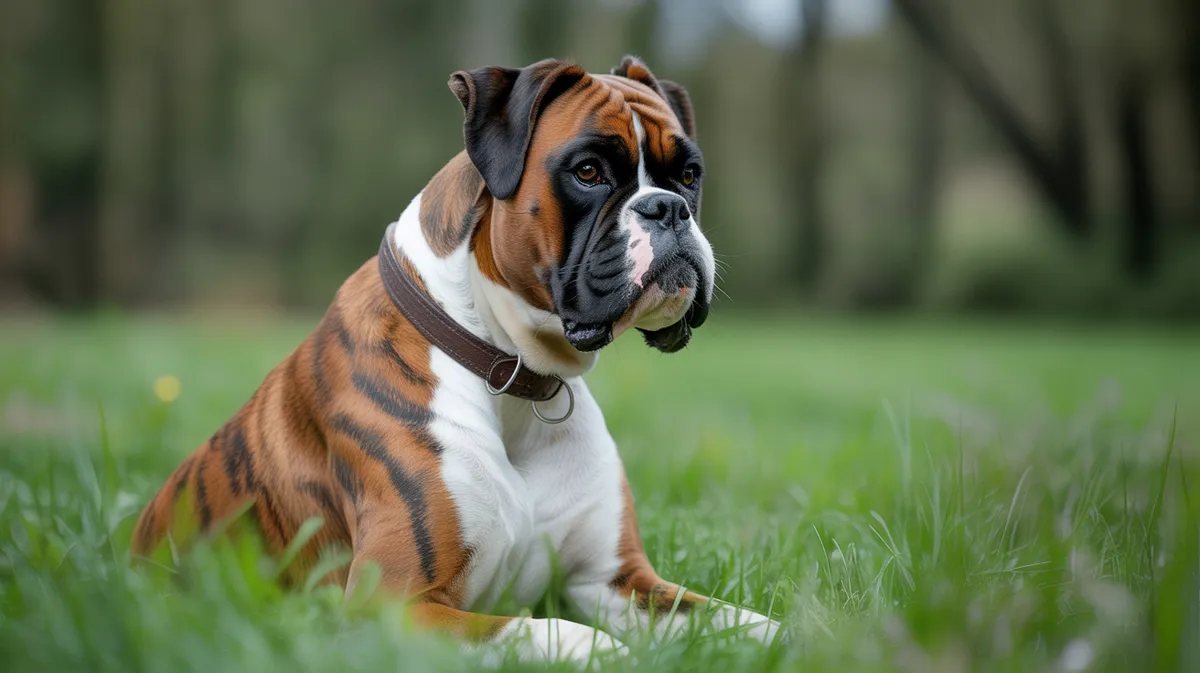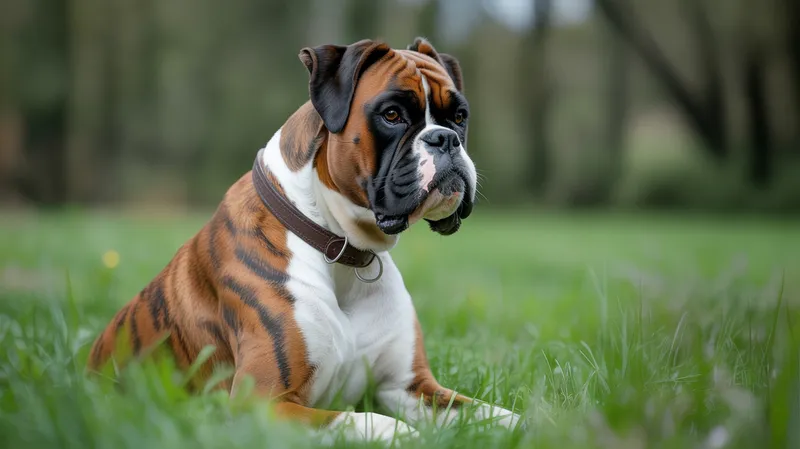
Boxer Dog
Canis lupus familiaris

Meet the Boxer Dog
The Boxer is a medium to large-sized breed of domestic dog known for its muscular build, short coat, and distinctive square muzzle. Developed in Germany in the late 19th century, Boxers were originally bred as hunting and working dogs, prized for their intelligence, agility, and loyalty. They are highly energetic, playful, and affectionate, making them excellent family companions. Boxers are also alert and protective, which makes them effective watchdogs. Their expressive faces and boundless enthusiasm are hallmarks of the breed.
Classification
Mammal
Habitat
Domestic
Diet
Omnivore
Lifespan
10-12 years
Conservation
Least Concern
Weight
25-32 kg (55-70 lbs)
📖Fascinating Facts
Boxing Stance
Boxers often stand on their hind legs and use their front paws to 'box,' a behavior that inspired their name.
Versatile Workers
Boxers excel as working dogs and have been employed in military, police, and search-and-rescue roles.
High Energy
This breed requires plenty of exercise and mental stimulation to stay healthy and happy.
📋Detailed Description
The Boxer dog is a robust, medium to large-sized breed, typically weighing between 25–32 kg (55–70 lbs) and standing 53–63 cm (21–25 in) at the shoulder. Characterized by a powerful, athletic build, Boxers possess a deep chest, strong limbs, and a short, tight-fitting coat that comes in fawn, brindle, or white, often with distinctive white markings. Their most notable anatomical feature is the broad, square-shaped muzzle and undershot jaw, which historically aided in gripping prey during hunting. Boxers are brachycephalic, meaning they have a shortened skull, which contributes to their expressive faces but can predispose them to certain respiratory issues. Highly intelligent and trainable, Boxers exhibit a playful, exuberant temperament and are known for their characteristic 'kidney bean' dance, a twisting body wiggle when excited. Social by nature, they thrive on human companionship and often form strong bonds with family members, including children. Boxers are alert and vigilant, making them natural guardians, yet they are generally friendly and non-aggressive when properly socialized. Their energy levels are high, requiring regular physical and mental stimulation. Lifespan averages 10–12 years, though some individuals may live longer with attentive care and health management.
💡 Did you know?
The Boxer breed descends from the now extinct German Bullenbeisser, a mastiff-type dog used for hunting large game such as boar and deer.
🔬Research & Sources
🎭Behavior & Social Structure
Boxers are highly energetic and require significant daily exercise, including walks, play sessions, and mental challenges such as obedience training or agility sports. They are known for their exuberant play style, often using their front paws to 'box' at objects or playmates, a trait from which the breed derives its name. Socially, Boxers are pack-oriented and thrive in environments where they can interact closely with humans and other dogs. They are generally patient and gentle with children, but their boisterous energy requires supervision around small kids. Boxers are alert and responsive, making them excellent watchdogs, though they are not typically aggressive without provocation. Their feeding behavior is omnivorous, but they thrive best on high-quality, protein-rich diets. Boxers are prone to separation anxiety if left alone for extended periods, which can result in destructive behaviors. They communicate through a range of vocalizations, body language, and facial expressions, often using their expressive faces to convey emotions.
👶Reproduction & Life Cycle
Boxers reach sexual maturity between 6–12 months, though responsible breeding is recommended after 18 months of age to ensure physical and behavioral maturity. The breed is monoestrous, with females coming into heat approximately twice per year. Mating is typically managed by breeders to ensure genetic health and temperament. Gestation lasts about 63 days, with litters averaging 6–8 puppies, though larger litters are possible. Boxer mothers are attentive and nurturing, providing warmth, grooming, and protection to their pups. Puppies are born blind and deaf, opening their eyes around 10–14 days after birth. Weaning begins at 3–4 weeks, and socialization is crucial from 3–12 weeks to ensure well-adjusted adult dogs. Breeding programs often screen for inherited conditions such as cardiomyopathy and hip dysplasia to reduce the incidence of genetic diseases.
🛡️Adaptations & Survival
Boxers have evolved several physical and behavioral adaptations suited to their historical roles as hunting and working dogs. Their muscular build and athleticism provide endurance and agility, while the short, smooth coat minimizes overheating during intense activity. The brachycephalic skull and powerful jaws were selectively bred to enable a strong grip on prey, though this trait now requires careful management due to associated health risks. Boxers possess keen senses of hearing and smell, enhancing their abilities as watchdogs and search-and-rescue dogs. Behaviorally, their intelligence, trainability, and strong desire for human interaction make them highly adaptable to various roles, including service, therapy, and police work. Their playful, inquisitive nature also aids in problem-solving and learning complex tasks.
📚Research Sources
🎨Cultural Significance
Boxers have played significant roles in human society since their development in late 19th-century Germany, where they were initially used for hunting large game such as boar and as butcher's dogs. Their loyalty, intelligence, and protective instincts have made them popular as family pets, guard dogs, and working dogs in police and military contexts. During both World Wars, Boxers served as messenger dogs, pack carriers, and guard dogs. In popular culture, Boxers are frequently depicted as playful, loyal companions in literature, film, and advertising. The breed symbolizes strength, resilience, and affectionate companionship. There are no known traditional medicinal or ritual uses, but their role as therapy and service animals is increasingly recognized.
🔬Recent Research & Discoveries
Recent genetic studies have focused on the Boxer’s predisposition to arrhythmogenic right ventricular cardiomyopathy (ARVC), leading to the identification of specific gene mutations (e.g., in the striatin gene) and the development of screening protocols for breeders. Ongoing research also addresses the breed’s susceptibility to certain cancers, with studies investigating environmental and genetic risk factors. Behavioral research highlights the Boxer’s high intelligence, problem-solving ability, and suitability for advanced training, including scent detection and assistance work. Advances in veterinary medicine have improved management of brachycephalic airway syndrome and hip dysplasia, enhancing quality of life and longevity. The breed is also a subject in comparative studies on canine cognition and social behavior.
🎥Wildlife Videos

The Boxer - Pet Dog Documentary English
The Boxer is a medium-sized, short-haired breed of dog, developed in Germany. The coat is smooth and tight-fitting; colours are ...
Best Documentary

Wildlife - Just Wild Dogs | Free Documentary Nature
Wildlife - Episode 7: Just Wild Dogs | Wildlife Documentary Watch 'Wildlife - Episode 8' here: https://youtu.be/kglJpB4ei8o Run ...
Free Documentary - Nature

Man's First Friend - The Epic Story of Dogs & Humans | Free Documentary Nature
Man's First Friend - Ths History of Dogs & Humans | Nature Documentary Watch 'Wildlife - Just Wild Dogs' here: ...
Free Documentary - Nature

An animal documentary unlike any you have seen before | The Wild Side of Dogs | Full Film
Raw and never succumbing to sentimentality or anthropomorphism. There is no music track to manipulate your feelings, instead ...
Journeyman Pictures

Wild Dogs: Pack vs Pride | FULL SEASON MARATHON
Wildlife filmmaker, Julz Braatvedt, returns to Zambia's South Luangwa National Park to follow the fortunes of two very different dog ...
Love Nature

THE AFRICAN WILD DOG: Nature’s Most Ruthless Pack Hunter Unleashed! | Animal Documentary
THE AFRICAN WILD DOG: Nature's Most Ruthless Pack Hunter Unleashed! | Animal Documentary THE AFRICAN WILD DOG: ...
WILD WORLD - Animal Documentary
🌍Habitat Information
The Boxer Dog typically inhabits Domestic environments. Boxer Dogs have adapted to their environments with specialized features and behaviors.
Primary Habitat:
Domestic
More detailed habitat information will be available soon.
🛡️Conservation Status
The Boxer Dog is currently classified as Least Concern. Conservation efforts are crucial for preserving this species for future generations.
Common Threats:
- 🏠Habitat loss and fragmentation
- 🌡️Climate change impacts
- 🎯Hunting and poaching
- 🏭Human-wildlife conflict
⚠️Threats & Conservation Challenges
While Boxers are not at risk in terms of conservation status, they face several health-related challenges due to selective breeding. Common inherited conditions include Boxer cardiomyopathy (ARVC), hip dysplasia, hypothyroidism, and certain cancers such as mast cell tumors and lymphoma. Brachycephalic airway syndrome is also a concern, particularly in hot or humid climates. Overbreeding and poor breeding practices can exacerbate these issues. Obesity is a growing challenge due to sedentary lifestyles in some domestic settings. Human impact is primarily positive, as Boxers are popular companion animals, but irresponsible breeding and lack of health screening remain ongoing concerns. Population trends are stable, with the breed ranking among the most popular worldwide, though regional variations in popularity exist.
🔬Scientific Classification
Scientific Name
Canis lupus familiaris
Classification Hierarchy
🔍 About Taxonomic Classification
Taxonomic classification is a hierarchical system used by scientists to classify and organize living organisms based on shared characteristics and evolutionary relationships.
The system moves from broad categories (Kingdom) to increasingly specific ones, with each animal's scientific name typically consisting of its Genus and species.
📝Community Notes
Share your observations and insights about the Boxer Dog with our community of wildlife enthusiasts.
Join Our Community
Sign in to share your observations and connect with fellow wildlife enthusiasts.
Sign In to ContributeNo community notes yet
Be the first to share your observations about the Boxer Dog!
Explore Boxer Dog
Select a tab above to learn more about this amazing animal.
📸Photo Gallery
No photos available for this animal yet.
🌟Discover More Wildlife
Continue your journey of discovery with more fascinating animals from our database
